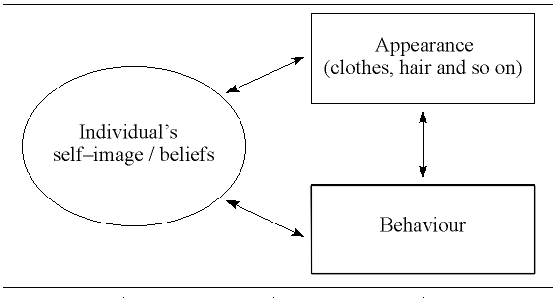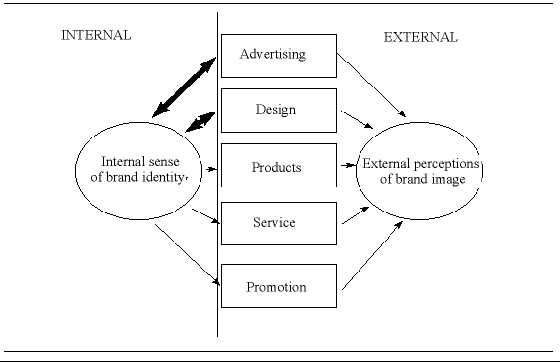Above the line advertising. It is still a key tool for building brands
Paul Feldwick,
BMP DDB Ltd, United Kingdom
WHAT IS BRAND IDENTITY?
Brand identity, as I shall use the term, is not a scientific construct that can be accurately defined or measured. It is more accurately seen as a metaphor. Just as individuals create and define themselves both internally and externally, so do brands.
A brand name, and the organisation or aspect of an organisation that it represents, is associated with a history, a defined position in the world, particular skills and talents and also weaknesses, certain characteristic behaviours which create the impression of a coherent 'personality', a life script or set of goals, and a value system.
In all these respects it is closely analogous to the human individual. The total of all these related elements is what I, following Professor Kapferer1 call the brand's identity.
Not all brand names are associated with a strong or coherent identity, but those that are have two kinds of advantage.
Firstly, the identity focuses the efforts and intentions of all those who are responsible for producing and marketing the brand.
Secondly, and by way of the first, it creates distinctive and attractive perceptions of the brand in the minds of its customers (I am happy to call this by the traditional name of brand image). I have discussed what brands mean to consumers at length elsewhere2.
I believe that there is an intimate relationship between the internal and external aspects of the brand's identity. See Figure 1.
It is easy to understand, I hope, that the external presentation of a brand should be driven by its internal goals and value systems, just as a person would dress and behave in a way that reflected how they feel and think about themselves. But it works the other way round, as well.
We all know how the way we dress can affect the way we feel and the way we think of ourselves; in fact we often consciously manipulate our mental states in this way, every time we put on a smart suit for a business encounter, or Bermuda shorts to get into a holiday mood. By changing our external appearance, we change not only the way we imagine ourselves, but also the way others respond to us, which in turn reinforces our changed self image. How often has someone said they 'feel like a different person', when they have some new clothes, or a new hairstyle? We can also change our internal, mental state by changing the way in which we behave, but often it is the change in something entirely external, like the new dress or the new spectacles, which acts as a catalyst to the other changes.
I now want to take this human analogy, and apply it back to brands. I suggest that the way a brand presents itself to the outside world has a similar intimate, two way relationship with its internal ways of behaving and its own 'self image'. Therefore, advertising or design (to name the two most important elements) are not only external representations of the brand's internal identity; they are also potentially powerful ways of modifying or enhancing that identity, and can therefore influence other aspects of the brand's behaviour. See Figure 2.
This may all sound very theoretical, but I hope it will become much more obvious if I give some illustrations. Here are three campaigns concerning which I have no privileged knowledge, but which I believe, first of all, are considered successful. In each case, I suggest that this advertising did not merely transform the way the public perceived the brand, but perhaps more importantly, changed the way the people working on the brand imagined it too. Thus becoming a catalyst to other aspects of behavioural change - customer service, product development and promotions, new product development.
Examples:
- British Airways 'Face'
- Tango 'Slap'
- Apple Macintosh '1984'
What's going on here? In all these cases, advertising took an abstract, and therefore often a vague idea, or just a feeling, about where the brand aspired to position itself in the minds of its customers and its own staff. It then created words, images, and/or music that gave these vague ideas a specific and precise expression. In retrospect it is easy to tag these executions with a simple strategic phrase that seems appropriate, and explain what they've done:
- British Airways: 'world's favourite'
- Tango:'street cred/ lager values'
- Apple Macintosh:'revolution'
But in each case, these words (if you can imagine them divorced from their executions) are vague, unconvincing, often clichs. In order to make people believe in them – and, importantly, this applies to people within the company, as well as its customers – they had to be turned into images.
Bill Bernbach once said. 'Properly practised creativity can lift your claims out of the swamp of sameness and make them accepted, believed, urgent'.
I believe he could equally well have said this substituting the words 'Brand Identity' for 'claims'.
Abstractions – and strategies are abstractions – are inert, clichs, general. Turning them into something else is the province of art.
I once went to a poetry workshop with the poet Carol Ann Duffy, who told us 'remember we're not in tell business, we're in show business'.
When people start to write they use abstract, conventional language such as 'I feel sad'. So what? You tell me how you feel – I've heard it a thousand times before, it doesn't mean anything. But create images and I can share in a precise and immediate and unique emotional experience.
Effective brand advertising does precisely the same thing, the only difference is that it has a commercial objective in doing it.
Brand identity can be expressed often more powerfully in images and in music more powerfully than it could ever be in words. Walter Pater once wrote that
All Art aspires to the condition of music,
meaning that art exists to express ideas that can't be well expressed any other way. Someone once asked T.S. Eliot, what did you mean when you wrote the line,
Lady, three white leopards sat under a juniper tree?
and he replied, 'I think I meant something rather like – 'Lady, three white leopards sat under a juniper tree'. If it could have been said better in other words, he would have said it.
Here are two more campaigns that had a profound effect on the way brands were seen, externally and, I believe, internally, which resist paraphrasing in any other way.
- Guinness 'Life on Mars'
- Volkswagen 'Casino', 'Changes'
The overused word 'surreal' doesn't begin to do justice to all the strands of meaning in the Rutger Hauer campaign. And I've spent many hours trying put into words what 'Casino' and 'Changes' say about Volkswagen: it's certainly a great deal more than 'reliability', which was the starting point for the campaign. There are many ways of explaining it, many of them equally correct and all of them, ultimately, inadequate.
Because it can express things that can't be said in other ways, advertising can often achieve things that at first glance appear impossible.
Consider the following three briefs:
- Make an anonymous brand of lager with a German name and advertising like this something lads want to be seen with in the pub
- Make a car that's known for safety look exciting – but without compromising the reputation for safety!
- Make a supermarket chain that's seen as a poor me–three to Sainsbury and Tesco seem more warm and friendly than the other two.
If you can imagine these briefs without having any notion of the advertising solutions, they sound like impossible dreams.
- Hofmeister 'Forest'
- Volvo 'Control Freak'
- Safeway ' Harry'
CONCLUSIONS
It's not my object to criticise the concept of 'integrated marketing', nor the usefulness of any of the other marketing tools that exist. On the contrary: both I, and the agency I work for, believe that 'integration' is essential to effective brand identity building.
But when we talk of integration, let us not forget the unique role that traditional media advertising – especially in audio–visual media – has to play in the overall mix.
Advertising offers a unique combination of creative scope and creative control. You could not do any of the things we've just seen in a mailshot.
You could perhaps get a similar degree of dramatic impact by sponsoring an event, but you then lose control over much of the content.
And for all the talk of 'new media' and 'advertising is dead', nothing else offers the ability to address so many people, both internally and externally, so cheaply. It is this sense of a shared experience that enhances advertising's ability to change the social meaning of a brand name.
Advertising has the ability to function as a catalyst, providing images that transform perceptions of the brand both among its consumers, and those who are responsible for delivering the brand to those consumers. So apart from its direct effects, it may have equally powerful indirect effects – what Stephen King once called increasing the 'sale–ability' of the brand. As a result, other marketing activities may become more productive. But more than this, all those involved with the brand - the staff who deal with the customers, the R&D people, the marketing groups, the other agencies who work on the brand – will share a clear and inspiring vision of how this brand is different.
It is difficult to fully quantify such effects from advertising. But we need to recognise their importance if we are not to undervalue the real contribution that advertising can make to a brand's performance.
ENDNOTES
1 Jean–Noel Kapferer Strategic Brand Management, London, Kogan Page, 1992. (Translated from Les Marques, Capital de l'entreprise Paris: Les Editions D'Organisation, Paris, 1991).
2 Paul Feldwick 'Defining a brand' in Understanding Brands, by Ten People who Do, edited by Don Cowley. London. Kogan Page, with the Account Planning Group, paperback edition 1996.
NOTES & EXHIBITS
FIGURE 1: INTERNAL AND EXTERNAL ASPECTS OF THE BRAND' S IDENTITY

FIGURE 2


